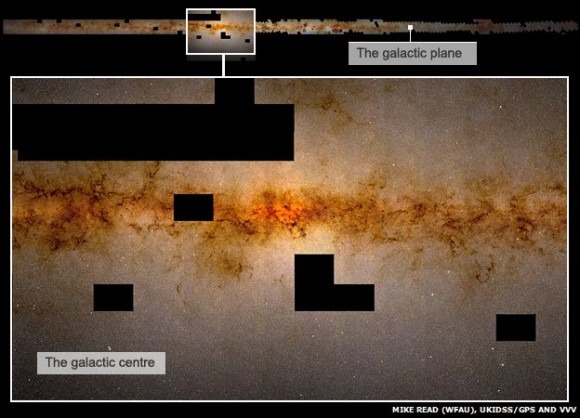Colossal Milky Way Photo Captures 'One Billion Stars'
Dr Nick Cross from the University of Edinburgh and associates of his at that institution have completed a 10 year sky survey data combination which will allow one single image (and the information embedded within) to display "about one billion starts." This is according to Cross who notes that this "is more than has been in any other image produced by surveys." This image can be seen in an extremely zoomed-in portion of an image as well as an expanded image which reads more like a river-sized landscape than it does a photograph.
These images (built in to the large image you see relatively tiny below) are compiled of individual images taken from UK-developed telescopes operating in both Hawaii and Chile. This project is known as the Vista Data Flow System, and data from the VVV survey data acquired by the Vista telescope in Chile as well as the UKIDSS/GPS sky survey acquired by the UK Infrared Telescope in Hawaii will be mined starting shortly. As Cross told the BBC this week:
"When it was first produced, I played with it for hours; it's just stunning. ... There are many uses for this picture. It will help us really understand the true nature of our galaxy, to see where everything is. Some researchers will use it to find star forming regions; there'll be lots of these along the plane of the galaxy." – Cross
What you're seeing in this extended image below is a very tiny representation of the full image, which will likely be showing up piecemeal across the web in coming months and years. The indicator that shows "The galactic plane" is what's been enlarged here as well, this showing the area where Earth is located. Say hi!

Nearly the entire right side of the image has been produced with data from UKIRT, while the left of the image was produced by Vista. The black blocks you see are areas that are still in the process of being filled. As Cross went on to say regarding what this image will be used for in the near future:
"Finding globular clusters will be another use. These are groups of very old stars that formed right at the beginning of the galaxy. We can study their distribution in this image and that tells us something about how the Milky Way started off. And it will be particularly useful to study anything that is extended. Here you can look at things on the large scale, to understand how they are related to each other; to look at things that might be across multiple images in a catalogue." – Cross
Space, the single photograph!
[via BBC]
